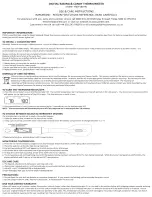
TEM PERING CHOCOLATE
3 STEPS TO TEMPER
WHITE OR MILK CHOCOLATE
DARK CHOCOLATE
STEP
#1: MELTING
113° to 118°F (45° to 47.7°C)
131° to 136°F (55° to 57.7°C)
STEP
#2: CRYSTALLIZATION
81° to 82°F (27.2° to 27.7°C)
82° to 84°F (27.7° to 28.8°C)
STEP #3:
WORKING (TEMPERED)
84° to 86°F (28.8° to 30°C)
88° to 90°F (31.1° to 32.2°C)
NOTE: once the chocolate has been tempered, do not let it's temperature rise above 91°F (32°C) otherwise you will need to retemper.
CANDY TEMPERATURE CHART
STAGE
TEMPERATURE
CANDY
COLD WATER TEST
THREAD
230 to 235°F (109° to 112°C)
Candies, simple syrups
Sugar cooked to this stage will be syrupy
and clear.
SOFT-BALL
235 to 240°F (112° to 115°C)
Fudge, fondant, pralines,
buttercreams
When dropped in a cup of cold water the
sugar will form a soft, pliable ball. When
removed from the water and placed on a
spoon, it will spread and flatten.
FIRM-BALL
245 to 250°F (118° to 121°C)
Caramels
A drop of sugar in a cup of cold water will
form a firm ball. When removed from the
water, it will keep its shape but can still
be squished between your fingers.
HARD-BALL
250 to 265°F (121° to 129°C)
Marshmallows, nougats,
rock candy
The sugar dropped from a spoon forms
threads. A drop in cold water forms a
hard ball that will not flatten between
your fingers.
SOFT CRACK
270 to 290°F (132° to 143°C)
Taffy, butterscotch
Smaller, tightly packed bubbles appear on
the surface of the cooking sugar. When
dripped into cold water, the sugar forms
flexible, bendable threads.
HARD CRACK
300 to 310°F (148° to 154°C)
Toffee, brittles, lollipops,
glazes
Sugar at this stage is very hot. A drop
placed in cold water forms hard, brittle
threads that crack when bent.
CARAMEL
320 to 338°F (160° to 170°C)
Caramel-coated molds,
praline, glazes
Sugar at this stage is caramelizing. There
is no water left in the sugar; it is a light
amber at the low end of the temperature
range, and a dark amber as it becomes
hotter.
BURNT-SUGAR
350°F(176°C)
The sugar begins to burn at this
temperature turning bitter in the process.
NOTE: for higher altitudes there are modifications that need to be made to candy recipes. For every 1,000 feet / 300 meters above
sea level, subtract 2 degrees Fahrenheit. For degrees C, for each 900 feet of elevation, subtract 1 degree Celsius.
KEY TEMPERATURES IN MAKING YOGURT
It is recommended to first heat milk to its boiling point of 180°F (82°C) and then allow its temperature to drop to 110 to 115°F (43 to
46°C). This is the temperature range that the milk should remain within throughout the remaining process. Please refer to full
recipes online for a complete guide to Yogurt making.


